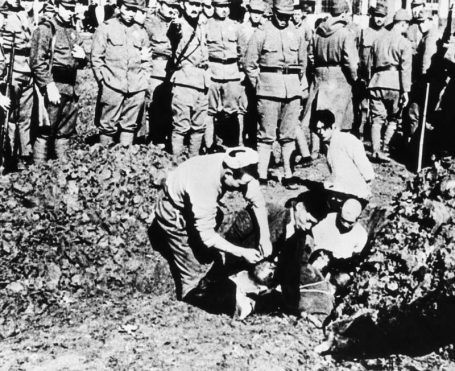By: Gabriel Galanti
This was a very emotionally charged week. These are tough stories, with a lot of controversial layers and conversations. I found The Rape of Nanking to be an incredibly thought-provoking piece. Iris Chang’s methodology centers around looking at the multiple perspectives of Japanese involvement in China during World War II. The first perspective is the Japanese perspective — how the breakdown of the army occurred, what orders were given, and how it was possible for the massacre to occur on the Japanese side. The second perspective focuses on the Chinese perspective and victims — the horrors that were experienced, the brutality they faced from the Japanese, and stories of extreme circumstances and unlikely survival. The last, and maybe most heavily weighted perspective, is the American and Japanese perspective. Chang takes the accounts of 3 individuals in the International Safety zone and examines their heroics and role in bringing the massacre to light.

Chinese victims about to be buried alive during the Nanjing Massacre
Interestingly, the structure of this week’s readings played an important role in dissecting the main theme of the week: what does it mean to be a historian and what does it mean to remember? We also read two articles by Daqing Yang that seek to answer these questions and describe what historical nuance means. The Nanking Massacre is a highly charged historical event with a lot of controversies and how we approach it is important. Yang specifically points to Chang’s use of certain sources and her questionable reading of them. While Chang is not a historian, misreading sources and information is important, especially when you consider that this was a New York Times bestseller and a lot of people used this novel to learn about what happened in Nanking. That’s kind of Yang’s point, that accuracy (along with historical judgment) is important. That being said, I enjoyed the class discussion on this fine line between historical accuracy and telling a ‘journalistic story.’
I really appreciated Neva, Lela, and Lupe’s points about how Chang’s methodology is not one of perfect historical accuracy, but rather trying to tell a story, and because of that they are willing to look past some of the murky historical spots in Chang’s book. I completely agree with their viewpoint, the whole of the controversy surrounding these events is always centered on the details, but the most important thing is that we stop and recognize that something bad happened here. I also appreciated Neva’s comments about not comparing two atrocities and simply focusing on scale. If we always focus on scale, numbers, and detail, we forget the emotional pain and trauma caused. It takes away from the historical narrative. That’s what makes it so interesting to properly remember something — there are multiple perspectives, multiple truths, and it’s hard to reconcile everything into one work. That being said, I do agree with Yang, that historical nuance and accuracy are important. The bottom line is that a combination of skepticism, nuance, and storytelling is needed to properly join a historical conversation — but history is an ever-changing and complex conversation — so our understanding of history is always moving and changing towards a complicated and nuanced truth.

A Chinese woman and man tied to a pole – Nanjing Massacre
My research project is going well! I have teamed up with Samantha Kosai and we are going to look at the depiction and experience of comfort women, how the representations of comfort women differ from place to place, and who is over or under-represented as a result. This paper will be reinforced by the readings in our class and a mix of outside scholarly articles. We will also look at the following movies: “Spirit’s Homecoming,” “The Apology,” “Great Cold,” “Gai Shanxi and Her Sisters,” and “Within Every Woman” and see what is available to review!
